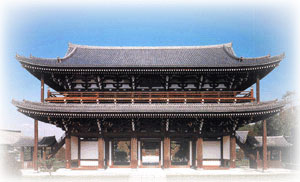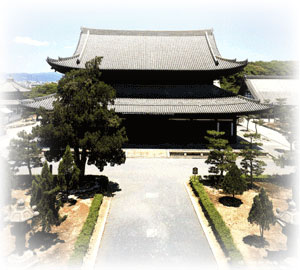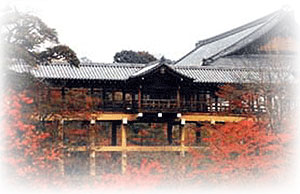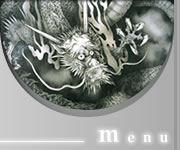
Tofuku-ji is the head temple of the Tofukuji branch of Rinzai Zen Buddhism
and number four of the Five Mountains of Rinzai Zen in Kyoto. Despite its
relatively low rank among the Five Mountains, it has throughout its history
been one of the largest and most important of the Kyoto Zen temples. It was
established in 1236 by the chancellor Kujo Michiie 九条道家 (1192–1252), who
desired to build in Kyoto a great Zen temple comparable in grandeur to the
great temples of Todai-ji 東大寺 and Kofuku-ji 興福寺 in Nara. The temple
name,Tofuku-ji, was taken from the “To” of Todai-ji and the “Fuku” of
Kofuku-ji. Construction continued from 1236 to 1255. The original Buddha
images of Tofuku-ji were among the largest in Japan: Tofuku-ji’s central
image, of Shakyamuni, was 15 meters in height; the two side images of the
bodhisattvas Avalokitesvara and Maitreya were 7.5 meters in height.
In 1243 Michiie designated
as founding priest Enni Ben’en 圓爾辯圓 (1201–1280), a deeply learned monk with
a background in Confucianism, Abhidharma thought, and the exoteric and
esoteric Tendai teachings, and with seven years (1235–41) of intense Zen
practice in China under the eminent master Wuzhun Shifan 無準師範 (J., Bujun Shipan; 1177–1249).
In 1246 Enni took up residence in the precincts of the partially completed
temple. At the time of Tofuku-ji’s founding, Zen was combined with Shingon
and Tendai practices, which Enni was well prepared to lead. Through Enni’s
efforts the Zen school, still relatively new to Japan at the time, won
increasing acceptance and respect in the capital.
 The temple suffered
disastrous fires in 1319, 1334, and 1336, but was rebuilt on its original
scale a little over twenty years after the 1336 conflagration. Subsequently Tofuku-ji enjoyed the patronage of important political figures like Ashikaga
Yoshimochi 足利義持 (1386–1428), Toyotomi Hideyoshi 豐臣秀吉 (1536-1598), and
Tokugawa Ieyasu 徳川家康 (1543-1616), enabling it to maintain its position as
the largest Zen temple in Kyoto. In 1881, however, it suffered another
disastrous fire. Reconstruction work continued for decades, and was only
completed in 1934, restoring Tofuku-ji to its original form. Its wooden
temple architecture is regarded as the finest in existence today.
The temple suffered
disastrous fires in 1319, 1334, and 1336, but was rebuilt on its original
scale a little over twenty years after the 1336 conflagration. Subsequently Tofuku-ji enjoyed the patronage of important political figures like Ashikaga
Yoshimochi 足利義持 (1386–1428), Toyotomi Hideyoshi 豐臣秀吉 (1536-1598), and
Tokugawa Ieyasu 徳川家康 (1543-1616), enabling it to maintain its position as
the largest Zen temple in Kyoto. In 1881, however, it suffered another
disastrous fire. Reconstruction work continued for decades, and was only
completed in 1934, restoring Tofuku-ji to its original form. Its wooden
temple architecture is regarded as the finest in existence today.
 The twenty-two-meter high Sanmon (Mountain Gate), built in 1425, is the oldest and largest Zen sanmon
in Japan. One its second floor are images of Shakyamuni Buddha and the
Sixteen Arhats. It is designated as a National Treasure. From 1969 to 1978
it was completely restored at a cost of 2.5 million dollars. The Sodo
(Monk’s Hall, built in 1347), Yokushitsu (Bath House, 1459), and Tosu
(Toilet; fourteenth century), Shoro 鐘楼 (Bell Tower; fifteenth century), Niomon 仁王門 (Two Guardian Kings Gate; 1597), and many more buildings, all
built in the classical style, are designated as Important Cultural
Properties. Tofuku-ji is also noted for its many excellent landscape
gardens, and for the beauty of its precincts during the autumn color season.
The twenty-two-meter high Sanmon (Mountain Gate), built in 1425, is the oldest and largest Zen sanmon
in Japan. One its second floor are images of Shakyamuni Buddha and the
Sixteen Arhats. It is designated as a National Treasure. From 1969 to 1978
it was completely restored at a cost of 2.5 million dollars. The Sodo
(Monk’s Hall, built in 1347), Yokushitsu (Bath House, 1459), and Tosu
(Toilet; fourteenth century), Shoro 鐘楼 (Bell Tower; fifteenth century), Niomon 仁王門 (Two Guardian Kings Gate; 1597), and many more buildings, all
built in the classical style, are designated as Important Cultural
Properties. Tofuku-ji is also noted for its many excellent landscape
gardens, and for the beauty of its precincts during the autumn color season.




 The temple suffered
disastrous fires in 1319, 1334, and 1336, but was rebuilt on its original
scale a little over twenty years after the 1336 conflagration. Subsequently Tofuku-ji enjoyed the patronage of important political figures like Ashikaga
Yoshimochi 足利義持 (1386–1428), Toyotomi Hideyoshi 豐臣秀吉 (1536-1598), and
Tokugawa Ieyasu 徳川家康 (1543-1616), enabling it to maintain its position as
the largest Zen temple in Kyoto. In 1881, however, it suffered another
disastrous fire. Reconstruction work continued for decades, and was only
completed in 1934, restoring Tofuku-ji to its original form. Its wooden
temple architecture is regarded as the finest in existence today.
The temple suffered
disastrous fires in 1319, 1334, and 1336, but was rebuilt on its original
scale a little over twenty years after the 1336 conflagration. Subsequently Tofuku-ji enjoyed the patronage of important political figures like Ashikaga
Yoshimochi 足利義持 (1386–1428), Toyotomi Hideyoshi 豐臣秀吉 (1536-1598), and
Tokugawa Ieyasu 徳川家康 (1543-1616), enabling it to maintain its position as
the largest Zen temple in Kyoto. In 1881, however, it suffered another
disastrous fire. Reconstruction work continued for decades, and was only
completed in 1934, restoring Tofuku-ji to its original form. Its wooden
temple architecture is regarded as the finest in existence today. The twenty-two-meter high Sanmon (Mountain Gate), built in 1425, is the oldest and largest Zen sanmon
in Japan. One its second floor are images of Shakyamuni Buddha and the
Sixteen Arhats. It is designated as a National Treasure. From 1969 to 1978
it was completely restored at a cost of 2.5 million dollars. The Sodo
(Monk’s Hall, built in 1347), Yokushitsu (Bath House, 1459), and Tosu
(Toilet; fourteenth century), Shoro 鐘楼 (Bell Tower; fifteenth century), Niomon 仁王門 (Two Guardian Kings Gate; 1597), and many more buildings, all
built in the classical style, are designated as Important Cultural
Properties. Tofuku-ji is also noted for its many excellent landscape
gardens, and for the beauty of its precincts during the autumn color season.
The twenty-two-meter high Sanmon (Mountain Gate), built in 1425, is the oldest and largest Zen sanmon
in Japan. One its second floor are images of Shakyamuni Buddha and the
Sixteen Arhats. It is designated as a National Treasure. From 1969 to 1978
it was completely restored at a cost of 2.5 million dollars. The Sodo
(Monk’s Hall, built in 1347), Yokushitsu (Bath House, 1459), and Tosu
(Toilet; fourteenth century), Shoro 鐘楼 (Bell Tower; fifteenth century), Niomon 仁王門 (Two Guardian Kings Gate; 1597), and many more buildings, all
built in the classical style, are designated as Important Cultural
Properties. Tofuku-ji is also noted for its many excellent landscape
gardens, and for the beauty of its precincts during the autumn color season.